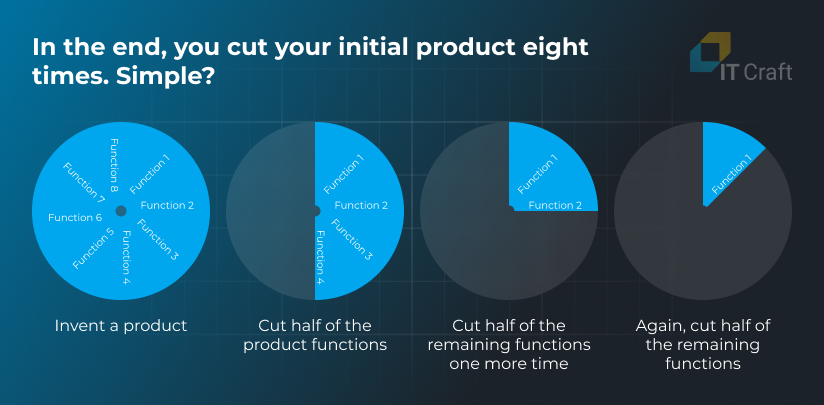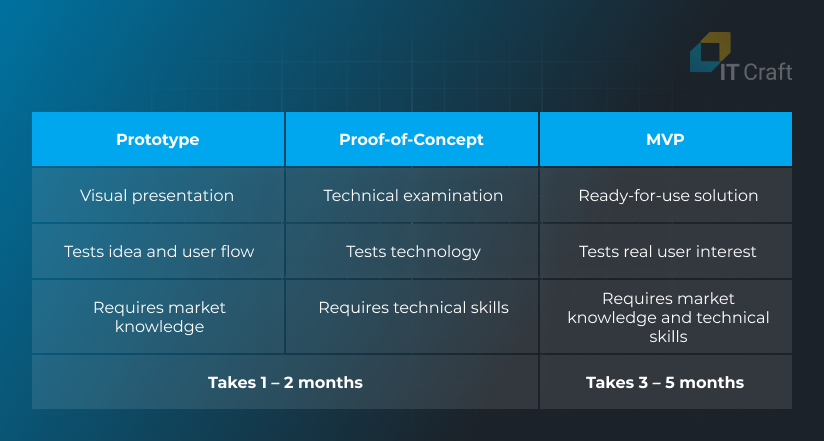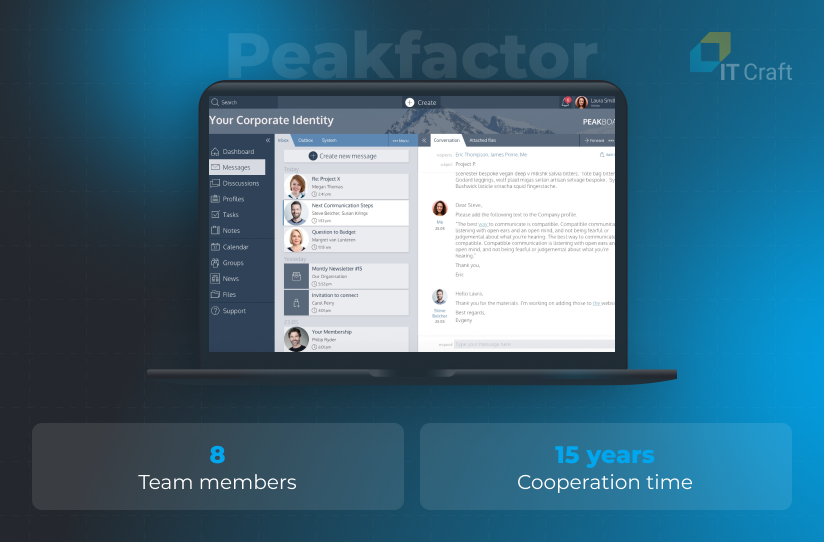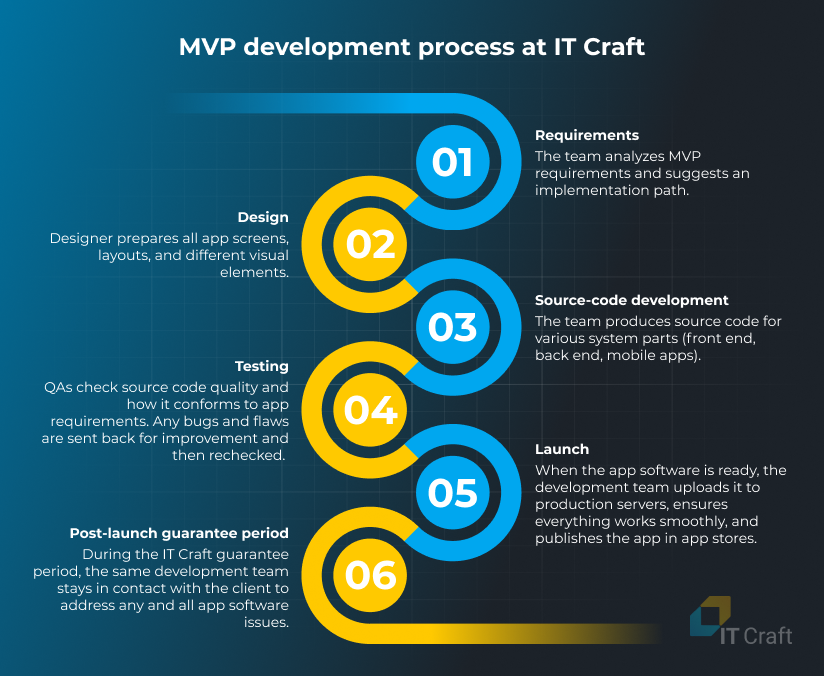What is MVP in software development? What should you care about this term? Here is why.
Are you an IT startup? If so, you and a tightrope walker share similar courage.
Are you sure you will successfully reach your goal? No. No one ever is 100% sure. Here is how to determine if your idea will catch on.
Here is why you should start with an MVP—a Minimum Viable Product.
Every successful business started where you are. They already have formulated strategies for startup success. Learn through their experience and heed their advice. In this article, we review the basic ideas of an MVP in general and the role of MVP in the software development domain.
1
What Is an MVP in Software Development?

In 2009 Eric Reis, a recognized serial entrepreneur, wrote his strategy in his famous book,
“Lean Startup.”
His advice:
- invent a product
- cut proposed product functions by 50%
- cut remaining functions by 50% one more time
- again, cut remaining functions by 50%.

Watch this insightful video by Eric Reis discussing the realities of building a Minimum Viable Product:
Source: https://www.youtube.com/watch?v=1FoCbbbcYT8
An MVP requires market expertise and expertise in software development. Neglecting either of these results in a poor product that does not solve your customers’ problems.
2
MVP vs. PoC vs. Prototype: Which One Do You Need?
Fresh startup founders might wonder about the difference between:
A (visual) prototype usually means a visual representation of a future product or its key part. It shows how the future product will function. Thus, visual prototypes make it possible to detect and eliminate flaws for a low investment.
PoC, a.k.a. technical prototype, assesses product feasibility. The development team examines the technical implementation and specific development technology of risks. In a worst-case scenario, an implementation might neither be possible nor worth the investment.
Prototypes are fast to launch.
Startups use prototyping to test the initial idea. They estimate risks, receive funding, then with the help of prototypes, become more specific about their plans.
Yet, prototypes do not target customers. Prototypes are not built with the customer in mind. They cannot download and start using a prototype.
An MVP is a minimally functional version of a new product in the making to collect user feedback. MVP in software development is a mobile or Web app which has gone live and is suited for customer use—this is what is MVP in software development.
An MVP comes after a prototype and a PoC when the idea and implementation strategy are clear.
All three are different steps for testing user requirements and product development strategy.
Also noteworthy is delivery time. A visual prototype and a PoC require 1 – 2 months of development; on average, an MVP requires 3 – 5 months.
1 – 4 specialists are enough to deliver a prototype. But a team of 4 – 11 developers might be required to work on an MVP depending on the list of requirements.

3
Successful Examples of an MVP
Here are a few now-famous MVP software development examples that grew into complex, sophisticated products:
Uber provides options for fast, reasonably priced taxi services.
- quickly find drivers
- estimate price of a fare
- pay with a credit/debit card via the app
Initially, Uber focused on users living in the San Francisco area, later expanded to other states.
Facebook
Helps us find friends and share information.
Facebook MVP was a comprehensive directory for and of Harvard students. It soon expanded to other universities. Two years after the initial launch, the network became globally accessible.
eBay
Started in 1995 as an experiment.
Its founder created an online marketplace MVP that soon boomed. When eBay’s maintenance costs increased, it began to charge for transactions. Yet, sales rates continued to grow, making eBay a profitable business.
Google
Is a superior search engine.
Its founders focused on backlinks as a source of meaningful data, providing more relevant search results.
Google’s search tools remain its core business. They have been enriched with distinctive features to improve its offered value.
Here are two more examples from IT Craft’s experience:
Peakfactor
Is one of our oldest clients from Germany. Our cooperation started with a small intranet MVP.
The client requested basic features for a custom network that a closed community of pharmacists uses. The MVP was successful, and the product continues to grow since its launch.

MyCarrier
Is an online portal for shipment management.
Its founders planned functionality for transparent, less-than-truck shipments. They validated the initial concept then expanded to truck shipments. The team focused on scaling as the number of users kept increasing.

Do you want a reliable team that knows how to handle the technical side of your MVP?
We can help.
Contact Us
4
Key Benefits of Investing in a Minimum Viable Product
Taking on challenges too often means making mistakes. Identifying those mistakes as early as possible is a winning strategy. MVP’s trial-and-error approach enables startups to reach success for less.
An MVP becomes the simplest and cheapest way to test demand and answer the following questions:
- How successful is the idea?
- What features work? What fail?
- How does the startup stay competitive based on feedback from real users?
The long-run benefits of a Minimum Viable Product include:
- Costs – startups do not blow their budget on irrelevant functionality.
- Timeline – time to market is faster when delivering only core features.
- Pace – an Agile approach as part of MVP strategy enables the team to stay on track.
- Focus – the entire team remains focused on end user demands.
An MVP is a proven way to attain the hoped-for, expected result and become one more success story.
5
How to build an MVP: Steps, Rules, and Points to Consider
As already mentioned, an Agile approach works best for startup projects.
Agile is a team-centric philosophy that allows organizing a flexible development process from within the team.
Software development steps
Below are the key stages that software development MVP solutions undergo:

MVP development rules
Keep the following when developing software MVP:
- Scalable architecture
- Easy and intuitive interface design
- Obligatory testing
- Shortest timeline possible
- Manageable budget
- Effective management
01 Scalable architecture. An MVP must allow seamless, easy addition of new functionality on top of it in the next cycles. To do this, developers include a scalable architecture in the MVP app. They do this from the very beginning.
02 User Interface design. An easy and intuitive MVP wins every time. Also, a great interface allows scaling in the future.
03 Testing. Yes, even small MVPs need testing to ensure users get what they want.
04 Timeline. There are many necessary actions to take during your MVP software development. Thus, finding out the shortest path for MVP creation is crucial.
05 Budget. MVP development costs vary. An MVP idea might be innovative and challenging to implement. You might have to test what exactly pays off! Be prepared to allocate a budget until tests prove your idea is working.
06 Management. Managing cyclic MVP development with all the above constraints should never be undervalued.
Common pitfalls
Is there anything on which you must keep constant focus? Yes, beware of common MVP development pitfalls:
01 Not learning from others’ lessons. Someone might have already implemented “your” idea without success. Pay a virtual visit to a collection of ceased projects before you start an investment:
02 Strive for perfection. When an MVP is good enough for shipment, ship it. You can polish it afterward. Stay away from endless iterations.
03 Wrong software development team. At first glance, an inexperienced team seems to cost less, but this is not the case. An inexperienced team could fail to deliver your hoped-for app. Instead, seriously consider how to find a programmer for your startup with a good management track record.
04 Lack of agility. Startups need to improve constantly based on discovered facts. Startups lose pace when the team is not Agile and flexible.
05 Chaotic processes. Flexibility does not equal unstructured processes. All team members must be aware of goals, roles, and workflow to work productively.
6
Minimum Viable Product is Now Live: What Comes Next?
The main idea of using an MVP in software development is testing the market with a bare-bones product version. You build an MVP, suggest it to your target audience, and learn the reaction.
Research results might surprise you!
Statistics cite that 93% of startups changed their initial business model based on user feedback (Amar Bhide, professor at Columbia University, in his book “Origin and Evolution of New Business”).
Hence, the startups:
- Learn how users interact with the MVP.
- Collect feedback.
- Analyze how feedback helps reach goals, e.g., increasing user acquisition or retention, stimulating in-app purchases, and more.
- Outline new improvements.
- Incorporate those improvements into the code base.
- Release an updated version of the product.
The cycle repeats until the startup figures out the right combination that makes end users happy. The startup reaches the envisaged goals in return.
Two points are important for success in custom MVP software development:
1. Surveying
First, startups need to identify user problems by interviewing users. Interviewing is difficult because people struggle to explain exactly what is wrong. They might not be aware of issues, too polite to say, or simply do not care. Startups should focus on the experience of using their product.
Second, metrics help identify flaws in UX that block reaching hoped-for goals. It is crucial to go through regular technical parameters such as session length, time spent on each screen, reported errors, and more to check if everything works.
2. Priorities
Startups should focus on features users want. Different users might suggest different paths. It makes sense to compose a list of all improvements. Then, startups prioritize those that bring the most value, improve KPIs, and are easy to implement within the next Sprint.
Any features requiring more time but are in less demand, can be scheduled later.
Here is what Michael Seibel, the managing director at Y Combinator, thinks of the product development process:
Source: https://www.youtube.com/watch?v=kzVvjKLdAbk
!
Conclusion
Taking on challenges means making mistakes. A winning strategy is identifying those mistakes as early as possible.
So, what does MVP mean in software development? Here is the answer:
MVP software development helps you determine if your product is a welcome addition to your users’ app world before investing too much in your idea.
With an MVP, you test your ideas with the least amount of investment. You can make effective business decisions based on feedback from real, active users.
Although an MVP is far from that great idea so many startups envision at the outset, it is the best way to get your expected result and become one more success story.
Of course, you need a technical partner who can implement your ideas. But not just any technical partner will do. You need a technical partner with in-depth experience in MVP software development services who understands the MVP meaning in software development and gives you suggestions on how best to implement your ideas in a Minimum Viable Product.
Do not be afraid to make mistakes and get negative feedback from your users.
Do not be afraid to change your ideas. This is exactly why you chose an MVP!








